Chapter 2 - Connecting Your Network
In AppleTalk terminology, an AppleTalk network consists of one or more AppleTalk devices on a single cable. Because the term "network" can mean so many things in different contexts (a VINES network, for example, is a set of computers and other components connected to at least one VINES server), the term LAN segment is used to describe AppleTalk devices on a single cable, if the term network would be unclear.
A LAN segment is not normally a single unbroken cable. It usually consists of a number of pieces of cable. In a bus network such as LocalTalk and Ethernet, the LAN segment begins and ends at the terminators. A ring network logically forms a ring, but physically has many cable segments, all connected into a central hub.
In a LocalTalk LAN segment, cables are attached to connector boxes. A LocalTalk cable is self-terminating; it begins and ends at the point where a connection box has only one cable connected to it. If a device is not at the terminating end of a LocalTalk LAN segment, one cable will lead from the device to a connection box. Two cables will leave the connection box, each to another device. A LocalTalk LAN segment is defined as the cabling and all its devices between two terminating ends.
Figure 2-1 illustrates a LocalTalk LAN segment.
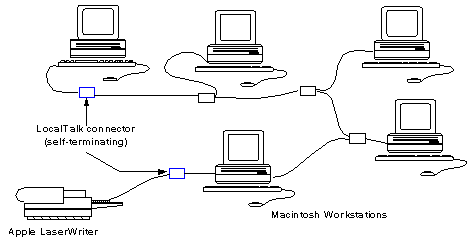
In Figure 2-1, the five Macintosh workstations and the Apple LaserWriter printer connected by the individual cables are on the same LAN segment. In AppleTalk terminology, they comprise an AppleTalk network.
An Ethernet cable can likewise be made up of many physical wires, but the LAN segment spans from terminator to terminator. Ethernet cables do not use connector boxes; instead they use T-shaped connectors where they connect to the workstation. Figure 2-2 illustrates an Ethernet LAN segment.

When one LAN segment is connected to another LAN segment by an internet router, they form an internet. An internet router is an intelligent node that functions as a packet-forwarding agent in the network. One example of an internet router is the AppleTalk Internet Router, a piece of software that runs in the background on an Apple Macintosh computer and can support all the features of AppleTalk Phase 2. VINES 5.0 can act as an AppleTalk router, interoperating with any router as long as the protocols on that router were implemented according to the AppleTalk specifications published by Apple Computer.
Figure 2-3 shows an AppleTalk Internet Router connecting two small LocalTalk networks.
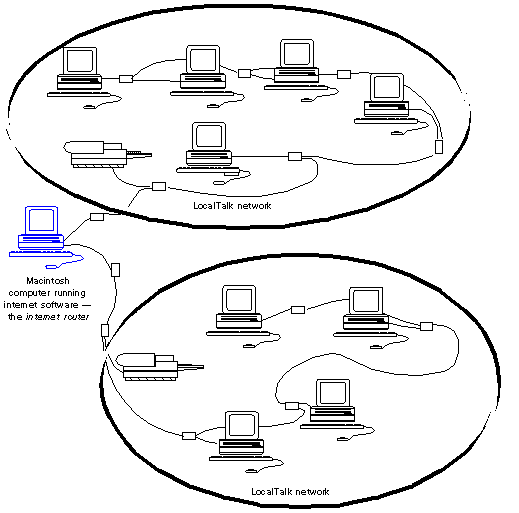
In a VINES network, the server, which already functions as an AppleShare file server, additionally acts as an internet router.
Figure 2-4 shows a VINES server acting as the internet router for two LocalTalk LAN segments (the printers), and two Ethernet LAN segments. LocalTalk cards on the server support the printers. Ethernet cards support the Ethernet LAN segments. Note that the Purchasing LAN segment contains both DOS workstations and Macintosh workstations.
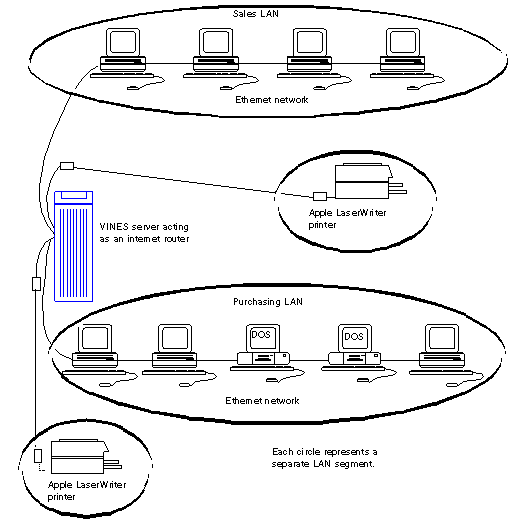
If you do not already have a map of your network topology, or a list of what devices are connected to which servers, start one now.
To uniquely identify the logical cable, or LAN segment, AppleTalk requires network numbers (AppleTalk Phase 1) or network number ranges (AppleTalk Phase 2). The AppleTalk protocol does not assign network numbers; you do. Deciding which networks will use which numbers is part of planning for using AppleTalk on VINES networks. You'll need some way of keeping track of which numbers you have assigned to which LAN segments.
For example, for each server, you could enter the information contained in the worksheet illustrated in Figure 2-5. Some of the items in the worksheet are discussed later in this chapter.
For larger, more complex networks, you'll probably want to use a network topology map like the one in Figure 2-6, possibly using color-coding or another scheme to identify zones.
| Server Name: USCHI001_________________________ | AppleTalk Phase 2 |
| Restricted? (Yes/No) No________________________ | |
| Tunnel to these servers: | |
| USCHI099_____________________________________ | ______________________________________________ |
| USCHI113_____________________________________ | ______________________________________________ |
| USCHI237_____________________________________ | ______________________________________________ |
| ______________________________________________ | ______________________________________________ |
| ______________________________________________ | ______________________________________________ |
| LAN Name | Description | Slot | Seed or Non-Seed | Network Number Range | Default Zone | Zone List |
| (none) | VINES port | VINES | Seed | 10 | VINES | VINES |
| Accounting (upstairs) | 3 DOS workstations 1 Macintosh IIsi workstation | 3 | Seed | 15-25 | FINANCE | FINANCE ADMIN |
| Apple Laser Writer | Shared printing near Accounting Department | 4 | Seed | 27 | ADMIN | ADMIN FINANCE CREDIT |
| Accounting executive area | 3 Macintosh IIci workstations | 5 | Seed | 30-35 | EXEC | EXEC ADMIN FINANCE CREDIT |

When planning your network, you have two decisions to make: which phase of AppleTalk to use, and whether to use media that support extended features (such as Ethernet or Token-Ring), or LocalTalk, which does not support extended features.
Which AppleTalk phase should you use on your network? In general, you should use AppleTalk Phase 2 for all your servers. The following list includes some additional reasons for choosing Phase 2:

Phase 2 supports TokenTalk networks. (Phase 1 does not.) 
Phase 2 on an extended network allows a theoretical maximum of 16 million nodes. (This theoretical maximum is subject to limitations, however, including distance.) Even using EtherTalk, a Phase 1 network can have a maximum of only 254 nodes. (A LocalTalk network, no matter which Phase it runs, is always limited to 32 nodes; it cannot reach the maximum of 254 nodes without an internet router.) 
On extended networks such as Ethernet and Token-Ring, Phase 2 permits multiple zones. 
Phase 2 offers improved performance on multiprotocol networks by reducing network interruption of non-AppleTalk nodes. 
Apple Computer recommends that customers use Phase 2. Their strategic direction for networking products is based on the features of Phase 2. With Phase 2, your network can remain compatible with AppleTalk products. 
If you already have a Phase 1 network, you can easily convert to Phase 2. Conversion is described in "Converting a Network to Phase 2" in this chapter. 
Phase 2 is the default for AppleTalk in VINES 5.0 and is the phase used in our examples in the following chapters of this book.
Configuring a Phase 1 network is slightly different from configuring a Phase 2 network. You will find Phase 1 configuration instructions in Appendix A
Table 2-1 summarizes the differences between Phase 1 and Phase 2.
| Feature | Phase 1 | Phase 2 |
| Data Links supported | LocalTalk, EtherTalk | LocalTalk, EtherTalk, TokenTalk |
| Maximum nodes | 254 nodes (except for LocalTalk, which is always limited to 32). | A theoretical maximum of 16 million nodes (except for LocalTalk, which is always limited to 32). |
| AppleTalk zones | Limited to 1 per LAN segment | More than 1 per LAN segment (except for non-extended networks like LocalTalk, which is limited to 1). |
| Network efficiency | Network traffic relatively heavy due to full routing updates and unnecessary traffic | Reduced traffic through best router selection and split horizon technique. |
A server can run only one phase of AppleTalk at a time. If you have workstations that use Phase 1 and workstations that use Phase 2 on a LAN segment connected to the same server, you can use a transition bridge to connect them. Figure 2-7 shows a transition bridge connecting two LAN segments running different phases of AppleTalk.

Some routers, such as the Shiva FastPath or the Cayman GatorBox, can also function as transition bridges. To use a transition bridge, refer to the documentation that comes with the bridge.
Instead of a transition bridge, you can use tunneling to connect LAN segments running different phases of AppleTalk. (You cannot, however, mix the phases on the same LAN segment unless there are two or more VINES 5.0 servers on the same segment.) "VINES Tunneling" later in the chapter describes tunneling.
If you have a mixed phase network (one that contains both Phase 1 servers and Phase 2 servers, or one that contains a transition bridge), the Phase 2 network numbers and zones must follow Phase 1 rules so that the Phase 1 and Phase 2 segments can communicate. (Configuration rules are described in "Managing AppleTalk Ports" in Chapter 3.)
With an existing network, you might not have a choice of which network type to use. For example, if you already have an AppleTalk network connected with LocalTalk cabling, it can be expensive to purchase Ethernet cards and cabling to replace LocalTalk on each workstation.
However, if you have Macintosh workstations that were not connected to your network before, there is a specific advantage to choosing Ethernet or Token-Ring: these network types can support the extended addressing features, which allow you to use network ranges and multiple zones. Also, Ethernet and Token-Ring are usually faster than LocalTalk.
Depending on which type of network you use - LocalTalk, Token-Ring, or Ethernet - there are certain limitations for Apple Computer' s implementation. Some of these limitations, such as the 254 node limit for an EtherTalk Phase 1 network, have already been mentioned. Table 2-2 summarizes the maximum nodes for each data link implementation under each phase. When planning your network, keep these numbers in mind.
|
|
Phase 1 | Phase 2 |
| LocalTalk | 32 nodes | 32 nodes |
| EtherTalk | 254 nodes | 16 million nodes |
| TokenTalk | Not Supported | 16 million nodes |
There are also limitations on distance. For example, a LocalTalk LAN segment cannot span more than 300 meters. For more information on distance limitations, consult the documentation for the media you are using. For example, if you are using a Token-Ring implementation, consult the documentation for the interface card which provides the Token-Ring support.
A hop is a step in the transmission of a packet from one node to another node through a router. Each intermediate router through which a packet is transmitted represents one hop.
A packet can travel over one or more hops, or no hops at all. A packet passing between two servers on the same physical medium goes through no hops.
An AppleTalk network cannot contain more than 15 hops. Keep this limitation in mind when planning the placement of routing servers.
When you use tunneling through VINES, which is described in "VINES Tunneling," this represents one hop. AppleTalk does not recognize any servers in the "tunnel."
Figure 2-8 shows how a tunnel appears as one hop. Between server USCHI001 and server USCHI099, there are two servers. However, AppleTalk cannot see those servers because they are in the "tunnel." To AppleTalk, the distance between server USCHI001 and USCHI099 is one hop.
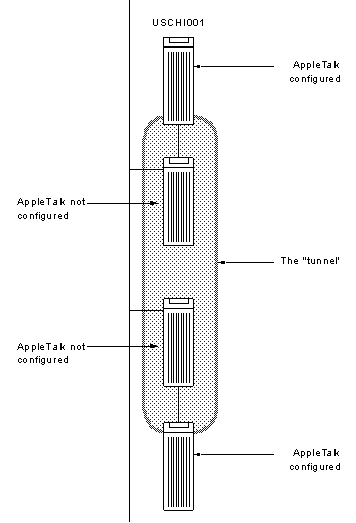
In AppleTalk running on a VINES network, there are 3 types of ports:

VINES ports 
Seed ports 
Non-seed ports
This section explains the differences between the types of ports and their uses.
A VINES port is a special type of port that is not associated with any card. You use a VINES port when:

You want to configure an AppleTalk port but the server has LAN cards that cannot support AppleTalk (for example, if the server is connected to an ARCNET network or uses an ICA card for X.25 communication). 
You want to configure an AppleTalk port on a VINES server that would not otherwise have AppleTalk ports configured. For example, you have a server that has no Macintosh workstations on the attached LAN segment, but contains files that Macintosh workstations elsewhere on the network will access through AFP, the AppleTalk Filing Protocol. "VINES Tunneling" describes this in more detail. 
You want a way to globally control tunneling on a server. (If you use the VINES port for tunneling, by disabling the port, you can disable tunneling globally for that server. "VINES Tunneling" describes tunneling.)
A VINES port must always be a seed port. Like other seed ports, a VINES port needs a zone name and a unique network number.
AppleTalk Seed and Non-Seed Ports
In an AppleTalk network, an AppleTalk port is a logical port that corresponds to the slot to which a LAN segment is connected. An AppleTalk port can be configured in one of two ways: as a seed port or as a non-seed port.
A seed port is a port to which you specifically assign network and zone information.
A non-seed port is a port that receives its network and zone information from a router on the LAN segment attached to the port. It learns about the addresses on its LAN segment dynamically, from information it receives from routers on the same LAN segment. In other words, it is seeded by other ports.
Note: Do not confuse seed ports with seed routers. A seed router is an AppleTalk internet router that informs routers on the same LAN segment of the network information and zone information for the LAN segment. In a VINES network, all VINES servers running AppleTalk are seed routers once their AppleTalk ports have initialized successfully. On the VINES servers, the ports may then be configured as either seed or non-seed.
In general, at least one router port per LAN segment should contain a seed port; the AppleTalk routing devices on that LAN segment need to get their network number and zone information from somewhere. This seed port can be on a VINES server or on another type of AppleTalk router. If there is only one AppleTalk router on the LAN segment, it should have a seed port. If you designate seed ports on two routers on a LAN segment, you have an automatic backup if one port is unavailable. (The seed ports on both routers must have identically configured information: the network number and zone information must match.)
With AppleTalk running on VINES, if you have a single Phase 2 LAN segment for your AppleTalk network, the AppleTalk port on the VINES server must be a seed port.
Examples of Seed and Non-Seed Ports
Figure 2-9 shows a single server network with two Ethernet LANs and two LocalTalk LANs. Since there is only one router in this network (the VINES server), there is only one router per LAN segment. In this example, each port must be a seed port.

If there' s more than one router, you can choose which ports will be seed and which will be non-seed. Figure 2-10 shows the same single-server network, but one that is connected to another router that functions as an AppleTalk internet router. In this example, a port on the router has been named a seed port, so the port on the VINES server that is on that LAN segment does not have to be a seed port.

The workstations on Personnel' s LAN can get their network number and zone information from either router.
If you wanted to make all the ports in Figure 2-10 seed ports, remember that if you have more than one seed port on a LAN segment, the zone list and the network number range must match. (The zone list is the group of zones names associated with an AppleTalk port.) For example, in Figure 2-10, if the single port from the router in the top right of the illustration is a seed port, the network number range and zone list assigned to that port must match the other port on the LAN segment. In Figure 2-11, those seed ports whose information must match are circled.

Seed ports must have numbers assigned to them. Table 2-3 shows an example of numbers that could be assigned to the ports attached to the server in Figure 2-11. Since this is a Phase 2 network, network number ranges have been assigned. However, the LocalTalk segments cannot have ranges, since LocalTalk does not support extended addressing, so single numbers are assigned to the LocalTalk ports.
| LAN Name | Network Type | Port Number | Network Number Range | Contents |
| Personnel printer LAN | LocalTalk | 3 | 10-10 | One LaserWriter printer |
| Personnel LAN | Ethernet | 4 | 15-25 | Three Macintosh workstations |
| Purchasing printer LAN | LocalTalk | 7 | 30-30 | One LaserWriter printer |
| Purchasing LAN | Ethernet | 5 | 31-40 | Three Macintosh workstations, two DOS or OS/2 workstations |
The port attached to the router in Figure 2-11 would also have a network number range of 15-25, since its numbers must match those of the other seed port on the LAN segment.
Assigning Network Numbers and Network Number Ranges
Once you have a list or map of your existing network, you are ready to begin to assign network numbers to the LAN segments on your network. LAN segments connect to a router through a port on the server. This port corresponds to a card on the server that resides in a slot. Therefore, it might be helpful to think of an AppleTalk port as a slot on the server. Each port, or slot, needs a network number or network number range.
For AppleTalk Phase 1 networks or non-extended Phase 2 networks, you assign a single network number. For AppleTalk Phase 2 extended networks, you assign network number ranges. You choose these numbers arbitrarily, following some simple rules that are described in the following section.
Choosing Network Number Ranges for a Phase 2 Network
Each LAN segment must have a unique number range associated with it. You need to define a starting point, the network range start number, and an ending point, the network range end number.
Using the example shown in Figure 2-6, there are four separate LAN segments. The Development and Marketing LANs also have a LaserWriter printer. The printer has its own LocalTalk LAN segment. (The LocalTalk LAN segment connects to a LocalTalk card on the server.)
In this example, AppleTalk Phase 2 on an Ethernet network is being used. Since Ethernet supports the extended addressing features of AppleTalk Phase 2, the following network number ranges could be used:
| Accounting's LAN | Network number range 1-5 |
| Development' s LAN | Network number range 6-10 |
| Development' s printer LAN | Network number 11 |
| Shipping/Receiving' s LAN | Network number range 12-16 |
| Marketing' s LAN | Network number range 17-21 |
| Marketing' s printer LAN | Network number 22 |
Note that the LocalTalk LAN segments that contain the two LaserWriter printers are assigned network numbers, not network number ranges. This is because LocalTalk does not support the extended addressing features of AppleTalk Phase 2.
Note also that the numbers are consecutive. With the exception of the printers, the network number ranges are also equal (each LAN has a range of 5 numbers). This is a matter of choice. You can choose any number from 1 to 65279. The following example would work just as well:
| Accounting's LAN | Network number range 8-10 |
| Development' s LAN | Network number range 60-62 |
| Development' s printer LAN | Network number 30 |
| Shipping/Receiving' s LAN | Network number range 16-45 |
| Marketing' s LAN | Network number range 1-3 |
| Marketing' s printer LAN | Network number 300 |
In a Phase 2 network, network number ranges cannot overlap. In other words, if you assign the range 8-10, you cannot assign another range 10-15; 10 is already used. See "Choosing Network Numbers for a Mixed Phase Network" for restrictions in a mixed phase network.
Choosing Network Numbers for a Phase 1 Network
Choosing network numbers for a Phase 1 network is similar to the method you use to choose network number ranges for a Phase 2 network. Each LAN segment must have a unique number associated with it. Any AppleTalk routers that tap into that LAN segment must use this same network number.
Look at the example shown in Figure 2-4 of a simple, one-server network. There are four separate LAN segments (two of the segments are LocalTalk segments for the LaserWriter printers). We could assign the LAN segments the following network numbers:
| Sales' LAN | Network number 1 |
| Sales' printer LAN | Network number 2 |
| Purchasing' s LAN | Network number 3 |
| Purchasing' s printer LAN | Network number 4 |
You can choose any number between 1 and 65535 for the network number. In this example, the numbers were consecutive, but they do not have to be.
Remember that two LAN segments cannot have the same number. Assigning duplicate numbers will cause network problems that might be difficult to isolate.
Choosing Network Numbers for a Mixed Phase Network
If you have a mixed phase network (one that contains both Phase 1 servers and Phase 2 servers, or one that contains a transition bridge), the Phase 2 LAN segments must follow Phase 1 rules so that the Phase 1 and Phase 2 servers can communicate. Figure 2-12 shows a mixed phase network.
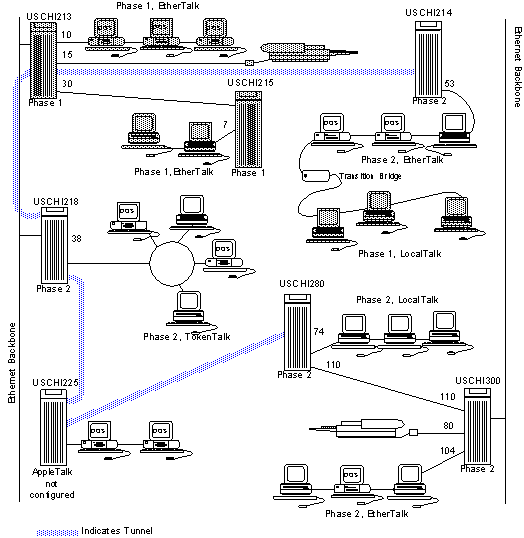
If you have a Phase 2 network that supports extended addressing (such as an Ethernet or Token-Ring network) with more than 254 nodes, choose network numbers that span a range. For example, choose a network start number of 5 and an end number of 10. If your network has less than 254 nodes, you might still choose a range to allow for future expansion.
In a mixed phase network, the Phase 2 segments must have a range of zero (for example, if the network range start of a particular LAN segment is 5, then the network range end must also be 5). Also, a mixed phase network cannot use zone lists; there can be only one zone per LAN segment.
Zone names, like network numbers and network number ranges, are assigned only to seed ports; non-seed ports pick up their zone information from other routers on the same LAN segment.
A Phase 1 network can have only one zone per LAN segment. A Phase 2 LAN segment running over a non-extended network such as LocalTalk can also have only one zone per LAN segment.
A Phase 2 network can have multiple zones per LAN segment. The group of zones names associated with an AppleTalk port is sometimes called a zone list. One zone is assigned as the default zone. The default zone is the zone to which any node on a particular network belongs until a different zone is explicitly selected.
Table 2-4 shows an example of zone lists and default zones for the seed ports in Table 2-3, shown earlier in this chapter. Note that the LAN segments containing the printers, which use LocalTalk, a non-extended medium, have only one zone.
| LAN Name | Network Type | Port Number | Network Number Range | Default Zone | Other Zones | Contents of LAN Segment |
| Personnel printer LAN | LocalTalk | 3 | 10-10 | PERS | One LaserWriter printer | |
| Personnel LAN | Ethernet | 4 | 15-25 | PERS |
PURCH ADMIN |
Three Macintosh workstations |
| Purchasing printer LAN | LocalTalk | 7 | 30-30 | PURCH | One LaserWriter printer | |
| Purchasing LAN | Ethernet | 5 | 31-40 | PURCH |
SALES MKTG |
Three Macintosh workstations, two DOS or OS/2 workstations |
If a server is not acting as a routing server, you do not need to configure separate AppleTalk ports. Using a VINES port, the server can pass AppleTalk traffic through the VINES network using a process called tunneling. (You might be familiar with this term already. A similar process is used with VINES TCP/IP.)
When AppleTalk packets travel through a VINES network, servers running the AppleTalk protocol encapsulate the packets with VINES headers. That is, they place VINES headers in front of the AppleTalk packet. This allows servers that are not running the AppleTalk protocol (such as servers running pre-5.0 versions of VINES) to pass the packets through; the packets appear to be normal VINES traffic.
For example, in Figure 2-13, AppleTalk ports have been configured on server USCHI001 and server USCHI017. An AppleTalk port has not been configured on Server USCHI027, which is between the two.
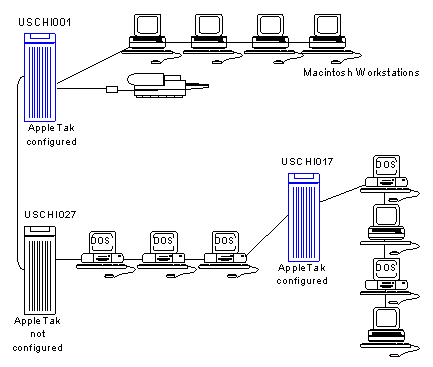
Before the AppleTalk packets leave server USCHI001, VINES attaches VINES headers to the packets. When they arrive at Server USCHI027, they appear to be normal VINES traffic, and VINES passes the packets along to Server USCHI017. The reverse is also true. Before AppleTalk packets leave server USCHI017, VINES attaches VINES headers to the packets. When the packets arrive at server USCHI027, they appear to be normal VINES traffic, and VINES passes the packets along to server USCHI001.
Another use of tunneling is in a network containing servers running a 4.xx version of VINES. For example, in Figure 2-13, server USCHI027 could be running VINES 4.10. (The servers at the ends of the tunnel, the ones with AppleTalk configured, must be running VINES 5.0 or later versions, since only VINES 5.0 or later versions have the AppleTalk software.) The encapsulated
packets leaving USCHI001 and USCHI017 appear as normal VINES packets to server USCHI027, and that server will pass the packets on. Even though server USCHI0127 can communicate in a VINES 5.0 network, it cannot be used for file storage since VINES 5.0 has a different file structure to accommodate the Macintosh file system.
In Figure 2-14, a small island of Macintosh workstations connected to Server USCHI120 store some of their files on Server USCHI199. Using tunneling you can configure this without having to configure AppleTalk on each intervening server. The intervening servers, the ones in the "tunnel," comprise only one hop.
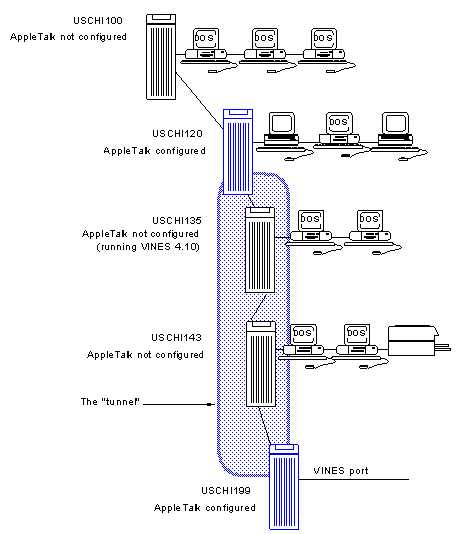
Part of your planning process will be deciding which servers will have AppleTalk ports configured, and which servers will route AppleTalk packets through VINES. Handling requests from Macintosh workstations and preparing information for Macintosh workstations require that you configure AppleTalk ports. You must configure either an AppleTalk port or a VINES port (VINES ports are described in Chapter 3) on a server that:

Contains a VINES file service or a print service (defined by MSERVICE at the workstation) which will be accessed from a Macintosh workstation 
Has a LAN connection that physically attaches a device that requires AppleTalk
Otherwise, a server can just pass AppleTalk packets along.
Using Tunneling to Connect Phase 1 and Phase 2
Another use of tunneling is to connect two AppleTalk LAN segments that are running different AppleTalk phases. In Figure 2-15, for example, USCHI001 is running AppleTalk Phase 1. USCHI017 is running AppleTalk Phase 2.
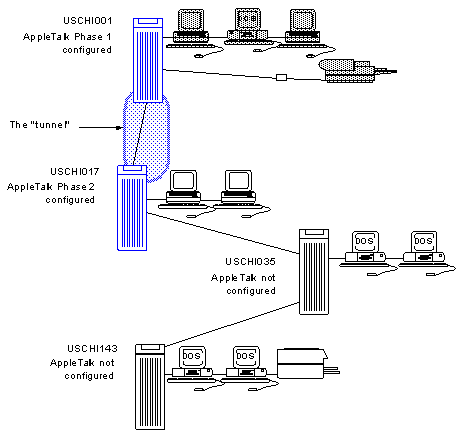
Chapter 3 describes the procedure for configuring AppleTalk ports to allow tunneling through VINES.
Connecting an AppleTalk Network to a VINES Network
All Macintosh workstations have built-in support for the AppleTalk protocol. Connecting Macintosh workstations to each other is usually very simple and is described in the reference manuals which come with the Macintosh workstation. The manuals that come with the LAN cards that support EtherTalk and TokenTalk describe how to install the hardware and driver software and how to connect the workstations.
Connecting an AppleTalk network to a VINES network varies according to the type of network (LocalTalk, EtherTalk, or TokenTalk) and whether you are connecting a simple, single network, or if you are connecting an internet (a network that contains an internet router such as the AppleTalk Internet Router).
If you are connecting two or more existing AppleTalk internets to a VINES network, make sure that network numbers (Phase 1) or network number ranges (Phase 2) on the two networks do not overlap. For example, if you have an existing AppleTalk network that uses network ranges 1-5, 10-21, and 23-39, make sure that no other AppleTalk network you are connecting to your VINES network is using that same range of numbers.
Regardless of the type of network you are connecting, check the cables, in this order, before starting the software:
1. Make sure that the cable for the node is attached to the LAN card before you switch the power on.
2. Make sure that the cables are connected to the appropriate card on the server before you start the AppleTalk software.
AppleTalk devices on the LAN segment will try to assign themselves identification numbers without waiting for the entire network to be connected. This number could already be taken by a device elsewhere on the network. If two devices have the same number, neither can be used on the network until they are switched off and switched on again.
Connecting a LocalTalk Network to a VINES Network
Since the Apple Computer LocalTalk cabling system provides a quick and simple way to connect Macintosh workstations to each other, many Macintosh workstations are connected this way. In some cases, these are small islands of workstations in a large corporation, separated from the corporate network. For example, art departments might use Macintosh workstations to create art, but might also have DOS or OS/2 workstations for mail and other networking activities.
If you have an existing LocalTalk internetwork connected by an AppleTalk internet router, you can connect this network to your VINES network. VINES is compatible with other AppleTalk routers.
If you have a group of Macintosh workstations connected by LocalTalk cabling, you can use LocalTalk cabling to connect them to your VINES network directly through the server, using a card that supports LocalTalk. Table 2-5 lists the LocalTalk cards that Version 5.0 of VINES supports. These cards are from Dayna Communications, Inc. Some support the standard LocalTalk communication rate of 230 Kbps; others provide faster rates. VINES 5.0 supports only the standard rate.
| Card | Bus Type |
| DaynaTALK DL/2 | Micro ChannelTM bus |
| DaynaTALK DL2000 | ISA (AT) or EISA |
| DaynaTALK PC | ISA (AT) or EISA |
| DaynaTALK MC | Micro Channel bus |
For more information on these cards, consult your local equipment dealer or the documentation that accompanies the cards.
Following the instructions that accompanies the cards, install the appropriate card in the server. Connect the LocalTalk connector box to the card in the server. Connect your LocalTalk network to the other socket in the connector box. Remember that a LocalTalk network cannot span more than 300 meters (984 feet).
Once the LocalTalk network is connected to the VINES network, it is just another LAN segment in the network. You must configure an AppleTalk port for this LAN segment. "Managing AppleTalk Ports" in Chapter 3 describes how to configure an AppleTalk port.
Note: Because LocalTalk cabling does not support the extended addressing features of AppleTalk, the configuration program, which can detect a LocalTalk card in the server, will prompt you for information as if you were configuring a Phase 1 LAN segment. This is a special case designed to support existing LocalTalk LAN segments.
Connecting PAP-Compatible PostScript Printers to a VINES Network
You can connect your PAP-compatible PostScript printers to your network in one of two ways:

By installing a LocalTalk card (as listed in Table 2-5) on the server, and connecting the printer to the resulting LocalTalk LAN segment. 
By using a bridge or other LocalTalk-to-Ethernet gateway between the printer (which uses LocalTalk cabling) and the server. You then use Ethernet to connect the bridge or gateway to the server.
Note: You can also connect a LaserWriter printer directly to a Macintosh workstation, but that printer would not be accessible from the network.
You must configure an AppleTalk port for the LAN segment to which the printer is connected. "Managing AppleTalk Ports" in Chapter 3 describes how to configure an AppleTalk port.
If you have not already configured a VINES 5.0 Print Service that the printer can use, you must configure one. Managing VINES Services describes how to configure print services.
Connecting to a VINES Ethernet Network
To connect to an existing VINES Ethernet network, simply connect your Macintosh workstation to an Ethernet cable that connects to a VINES server that is running VINES 5.0.
On the VINES 5.0 server, configure the Ethernet card according to the directions provided with the card. If the card has already been configured to run VINES, you do not have to reconfigure it to run AppleTalk over a VINES network.
Once the Ethernet network is connected to the VINES network, it is just another LAN segment in the network. You must configure an AppleTalk port for this LAN segment. "Managing AppleTalk Ports" in Chapter 3 describes how to configure an AppleTalk port.
Connecting to a VINES Token-Ring Network
For VINES 5.0, IBM Token-Ring source-level routing for AppleTalk is not supported. Macintosh workstations must be directly connected to a Token-Ring card on a VINES 5.0 server.
On the VINES 5.0 or greater server, configure the Token-Ring card according to the directions provided with the card. If the card has already been configured to run VINES, you do not have to reconfigure it to run AppleTalk over a VINES network.
Once the Token-Ring network is connected to the VINES network, it is just another LAN segment in the network. You must configure an AppleTalk port for this LAN segment. "Managing AppleTalk Ports" in Chapter 3 describes how to configure an AppleTalk port.
Converting a Network to Phase 2
To take full advantage of AppleTalk Phase 2, you must convert all routers and other nodes on your network. If you do not, and you have a mixed phase network, the network is still limited to the features of Phase 1.
Perform the following steps when planning to upgrade your network.
1. Review your current network numbering scheme. If network number ranges overlap, you must assign new numbers. You might want to assign new network number ranges.
2. Review your zone assignment. Since AppleTalk Phase 2 running on an extended network allows multiple zones per LAN segment, you might want to devise a zoning scheme to take advantage of this. Use zones to logically group workgroups together. For example, you could use zone Mktg to designate the resources that belong to the work group called Marketing.
3. If you are using internet routers other than VINES servers, check the revision level of the software and verify that the software will support AppleTalk Phase 2. Obtain any necessary upgrades and instructions for installing the upgrades from your software supplier.
4. Check the revision level of the EtherTalk and TokenTalk drivers on your network. You must upgrade all Macintosh workstations using EtherTalk to AppleTalk Phase 2 drivers. (Nodes on LocalTalk LAN segments do not require conversion.) Obtain the necessary drivers and instructions for installing the drivers from your Apple Computer dealer.
5. If you are using third party network cards or third party network applications, check the revision level of the drivers and verify that the drivers will support AppleTalk Phase 2. Obtain any necessary upgrades and instructions for installing the drivers from your software supplier.
If you cannot convert all of your network at once, you can use a transition bridge. On very large networks, transition bridges are often used as temporary measures while the network is slowly being converted to Phase 2. Using transition bridges on a permanent basis in your VINES AppleTalk network is not recommended.
If you do not already have a transition bridge available, you can use VINES tunneling to bridge AppleTalk Phase 1 LAN segments to AppleTalk Phase 2 LAN segments. "Routing Through VINES Networks" in Chapter 3 describes how to configure tunneling.
Depending on the size and complexity of your network and the need for continuous operation in some areas, you may decide to use one of the following methods to convert your network:

Bring down the entire network and convert it all at once. (This method is more practical for small- or medium-sized networks, or networks that do not need to operate continuously.) 
Isolate the Phase 1 LAN segments temporarily. As each one is upgraded, join it back to the enterprise-wide network. 
Use VINES tunneling or transition bridges so that Phase 1 LAN segments can still be a part of the network while waiting for conversion.
Converting all networks at once is ideal for small networks, and very practical for medium-sized networks. You can use this method, too, for large networks when there is plenty of time available (during a holiday weekend, for example), and you can shut down the network without an adverse impact on the business. Obviously, this method is not recommended for critical applications that cannot afford any time lost.
The advantage of converting all at once is that it is the simplest method.
This chapter discussed AppleTalk topology and planning issues. Once you have decided on your network configuration, proceed to Chapter 3, which describes how to use the configuration menus to configure your network.
For more information on planning your VINES network in general, refer to Planning a Banyan Network.
For more information on the AppleTalk protocols or network numbers, refer to AppleTalk Network System Overview or Inside AppleTalk. (Both are publications of Apple Computer, Inc.)